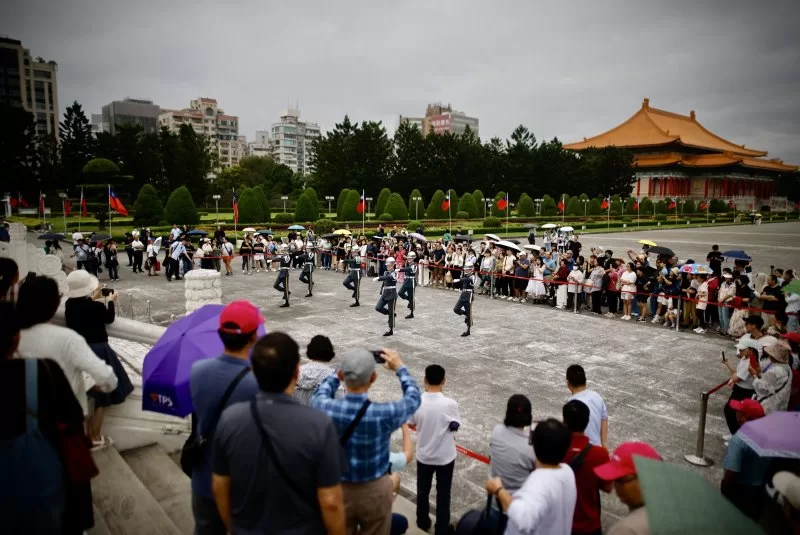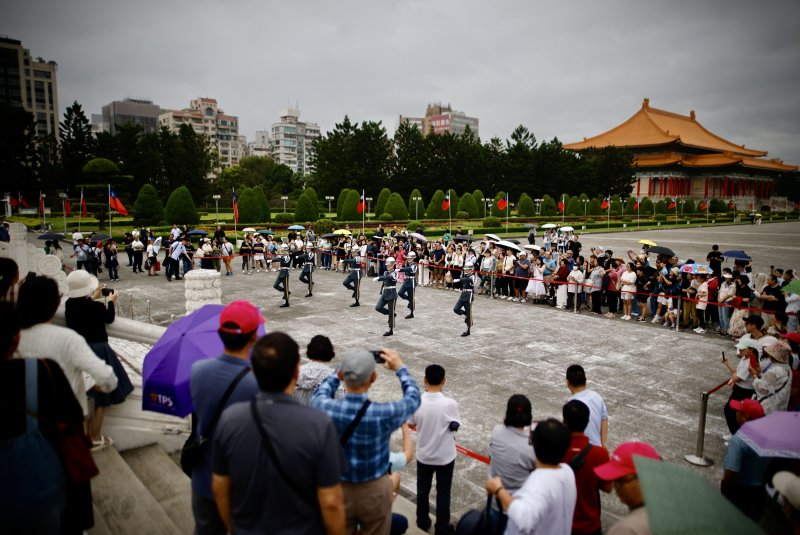People observe the changing of the honor guard in front of Chiang Kai-shek Memorial Hall in Taipei’s Liberty Square on Tuesday after Chinese forces staged live-fire drills just 65 miles away off Niushan Island in the Taiwan Strait. Photo by Ritchie B. Tongo/EPA-EFE
Oct. 22 (UPI) — China’s military conducted live-fire drills Tuesday off an island 65 miles northwest of Taiwan involving 26 ships and aircraft, some of which crossed the so-called median line down the middle of the Taiwan Strait.
The exercises took place for several hours before dawn with nine People’s Liberation Army ships and 17 PLA aircraft detected operating around Taiwan, the Ministry of National Defense of Taiwan said in a post on X.
“Eleven of the aircraft crossed the median line and entered Taiwan’s northern, central, and southwestern Air Defense Identification Zone. Republic of China Armed Forces have monitored the situation and deployed Combat Air Patrol aircraft, navy vessels, and coastal missile systems in response to the detected activities.”
It added that the drills around the Chinese island of Niushan were part of an annual “routine military exercise” and suggested they may have been aimed at “exerting deterrence in the Taiwan Strait.”
However, Taiwan Premier Cho Jung-tai, while offering reassurance to the people of Taiwan worried for their security and insisting that the island’s military was fully prepared for any eventuality, slammed the exercises saying they were a threat to regional peace and stability.
“No matter how large the scale of the drill is, they should not be frequent and close to Taiwan,” he told a news briefing.
“This will only cause unnecessary tension.”
Tuesday’s drills, the latest in a dramatic uptick in incursions by Chinese warships and aircraft into Taiwan waters and airspace since the January election of President William Lai Ching-te of the Democratic Progressive Party which Beijing views as pro-independence, follow a major show of strength involving all branches of the PLA last week.
Codenamed Joint Sword-2024B, the unprecedented military exercises around Taiwan on Oct. 14-15 involving the army, navy and rocket force to “serve as a stern warning to the separatist acts of ‘Taiwan Independence’ forces,” drew strong condemnation from the United States.
Taiwan’s MND said China had deployed 14 warships and 12 other naval vessels around the island during the exercise as well as 153 warplanes of which 111 entered Taiwan’s southwestern and eastern ADIZ, across the median line.
Beijing mounted Joint Sword four days after Taiwan celebrated its National Day on Oct. 10 during which President Lai said in a speech that China had “no right to represent Taiwan.”
The U.S. State Department said Beijing’s reaction was “unwarranted” and risked escalation, urging the Chinese government to exercise restraint and “avoid any further actions that may undermine peace and stability across the Taiwan Strait.”
The Pentagon telegraphed its ire over the exercises in no uncertain terms.
“This military pressure operation is irresponsible, disproportionate and destabilizing,” said U.S. Defense Department press secretary Maj. Gen. Pat Ryder in a statement in which he noted that Lai’s speech was “a long-standing tradition” and “a routine, domestic-focused address” that hitherto had prompted little to no reaction from Beijing.
Analysts said messages disseminated by Beijing saying that its forces’ heart-shaped formation around the island was an “expression of love” was part of its psy-ops strategy to try to normalize the staging of military exercises near Taiwan.
“China’s military exercise is intended to undermine Taiwan’s morale with information warfare,” the Taipei Times quoted Taiwan National Security Association researcher Chen Kuan-hsien as saying.
He added that they also sought to test how Taiwan and the international community would respond as part of a multi-disciplinary strategy that in addition to military operations encompassed diplomatic, communications and technological approaches.

